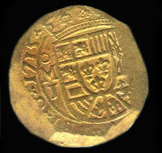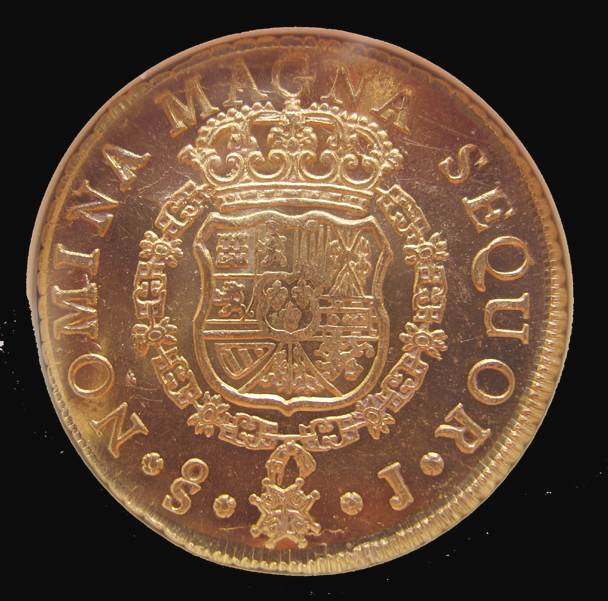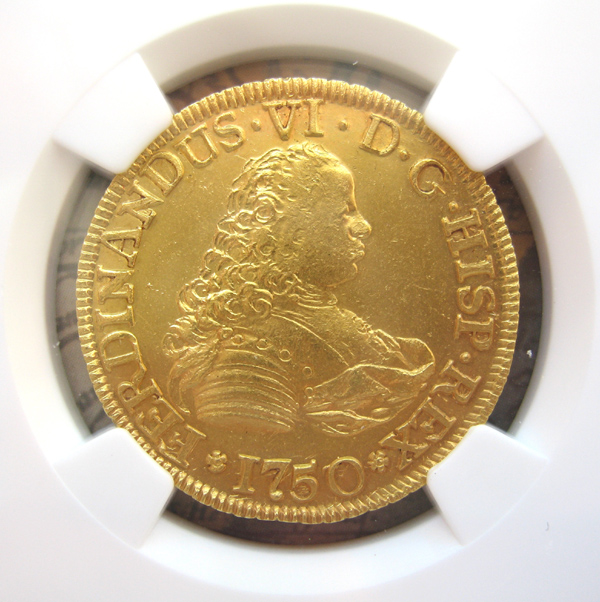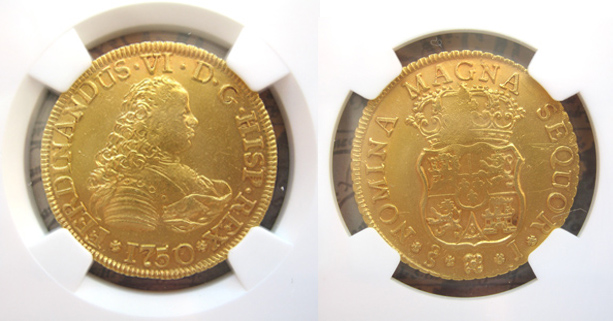 |
|
|
|
|
||
|
Latest News "Essential Books" Click here
|
PORTRAIT GOLD FROM THE 1752 MONTEVIDEO SHIPWRECK OF
NUESTRA SENORA DE LA LUZ
Z1. The one of the finest Santiago 8 escudos recovered from the wreck of Nuestra Senora de la Luz. A high-relief 8 escudos with very deep prooflike fields, a proof-quality specimen. SOLD
The decline of Spanish power in the Pacific and Caribbean meant that by the mid-18th century gold for the Spanish crown was often transshipped across South America and embarked for Spain at Buenes Aires, Montevideo or other Eastern ports. Because of the tragic loss of Nuestra Senora de la Luz in Montevideo harbor in July 1752, we have a window on the beginnings of coinage at the new Santiago mint and the final cob coinage at Lima. Without the treasure of the Luz, most of these issues would be known only from literary sources or from a few well worn examples. Among the treasure of the Luz was a shipment of new 1751 Santiago onzas. When Ruben Collado salvaged the Luz in 1992-93, he made a study of the Santiago onzas, before dividing the treasure between two large public sales and some private sales. This coin is from a die combination Collado calls M/7 (see the Sotheby's catalogue for the diagnostics of the varieties). Like most of the best Santiagos, this one was sold privately by Collado in 1993 and resided in a large private collection until making a recent trip to NGC.
I have seen hundreds of Santiago 1751 onzas from the wreck of Nuestra Senora de la Luz, including the Sotheby's coins offered in March 1993. Almost all fall in the AU55- MS61 range, held back by poor strikes (especially on the bust of Ferdinand VII) and by sea corrosion. For reasons not yet understood, the new mint at Santiago decided to strike their onzas in high relief and on polished planchets. In a word, in proof quality! Like our own experiment with high-relief gold in 1907, the Santiago mint's noble experiment soon proved impractical. Most onzas came off the dies with poor strikes on one or both sides. Government officials complained about the ugly, flatten bust of Ferdinand, and by 1752 the mint went back to striking onzas with normal relief. But among the onzas of 1751, those few that did come off the dies with full strike remain perhaps the most attractive gold issue of the Spanish Americas.
Sea corrosion hurts the Santiago onzas principally by darkening their highly reflective fields. The deep prooklike surface remains visible in the sheltered areas of the legends, while the open fields especially around Ferdinand's bust are dull and dark. This darkening unfortunately besets and impairs some onzas with superior strikes. A very few coins, then, came off the dies at Santiago with full strikes and deep fields and then miraculously survived 240 years at the bottom of Montevideo harbor.
Three or four 1751's stand out in my mind. A deep prooflike coin similar to this one, but baggier and graded an MS63, bought $8050 at a Heritage auction in Sept 2007. Another very choice coin, not quite as prooflike and graded MS 63, brought $7500 in a private mid-2008 sale. The 1751 offered here is a level above both these coins. My photos do not do it justice. Proof gold photographs poorly. If you've collected Proof US Liberty Double Eagles, you know what I mean. For the collector of Spanish Colonial onzas who wants the best, this is the coin.
Sold terravitan@aol.com or 480-595-1293.
********************************************************************
Z2. A rare Santiago 1750 four escudos, the entire surviving population of about 130 coins recovered from the wreck of Nuestra Senora de la Luz. This curious variety shows the final digit 0 repunched over a 5. Apparently the die engravers had originally dated the issue 1755! A few dozen example of this terribly struck early issue show the 1750/5 overdate.
This curious variety shows the final digit 0 repunched over a 5. Apparently the die engravers had originally dated the issue 1755! Only a few dozen example of this early issue show the 1750/5 overdate.
NGC in their wisdom have decided to call this absolutely mint state LUZ four escudos an AU 58, confusing, I suspect, strike and wear. NO 1750 Santiagos are well struck or even decently struck. In the first two years of operation the new mint at Santiago did not know how to control striking pressures. It was not until 1751 that well struck 8 and 4 escudos began to be produced in Santiago. This 1750 is far above average in the quality of its strike. Detail on the bust of Ferdinand and on the Bourbon shield is quite good compared to most the surviving population. The coin has excellent luster over prooflike fields. My photos do not do it justice.
Available. Please inquire.
terravitan@aol.com or 480-595-1293
©2007 Goldcobs.com All Rights Reserved.
©2007 Goldcobs.com All Rights Reserved.
|





